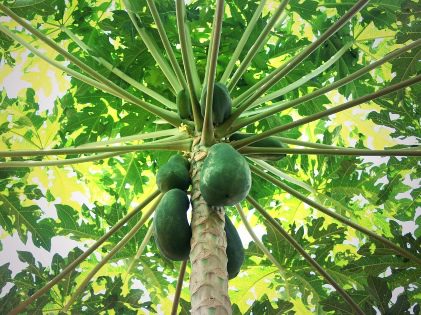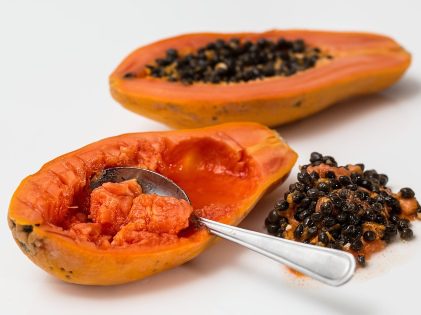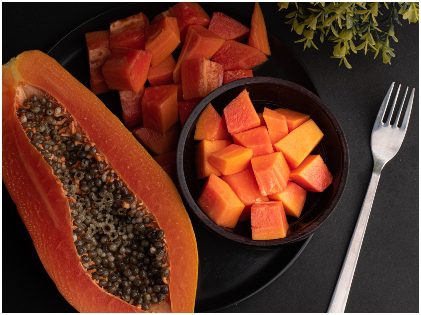If you make a list of ‘America’s Top Secret Fruits,’ Pawpaw would surely top it as fewer people are aware of this hidden gem. If you want to swing by your local grocery store, even a supermarket, you could be disappointed due to the hard-to-find nature of this fruit. While the exotic fruit is yet to make its sensation amongst the public, it is probably the largest in native America. You can consume Pawpaw directly, or you can smash it into several unique dishes. All thanks to amazing culinary possibilities and nutritious values.
Pawpaw, What Is It?
 Pawpaw is the largest known native American fruit. Generally, 3-6 inches long, it sometimes looks like a giant mango or any other tropical fruit. The fruit is more harvested in the midwest or Great Lake region of North America.
Pawpaw is the largest known native American fruit. Generally, 3-6 inches long, it sometimes looks like a giant mango or any other tropical fruit. The fruit is more harvested in the midwest or Great Lake region of North America.
The trace of Pawpaw takes us to the period long before the settlers had invaded the continent. This fruit is primarily sweet-tasting with a unique custard-like texture similar to the sapodilla fruits grown in Mexico or other tropical regions. While the fruit remains a secret gem, the demand has escalated ever since NPR aired a special story about it in 2011.
Is it Nutritious Enough?
Pawpaw is just the biggest edible fruit in North America. But the unique flavors and nutritious value keeps it a notch ahead in the competition. The flavor is similar to a mixture of mango and banana, while the little citrus taste and creamy flesh inside make it unique.
Some wild pawpaws may not taste pleasant as commercial ones. But the nutrition value they all carry is too good to be ignored. Tree-ripened pawpaws can easily fall off the trees. You can keep Pawpaw in the refrigerator to ripen and extract the entire pulp within a day for the best wholesome values. Now, let’s discuss its nutritional and culinary possibilities in detail.
Exceptional Manganese Value and Nonheme Iron
 Pawpaws have 113% of the daily value of manganese, which is way more than any other fruit of this similar category. Although experts referred to its skin as the major source of manganese value, the pulp also has enough of them for your regular intake. This fruit also is an excellent source of nonheme iron, good for your immune system and metabolism.
Pawpaws have 113% of the daily value of manganese, which is way more than any other fruit of this similar category. Although experts referred to its skin as the major source of manganese value, the pulp also has enough of them for your regular intake. This fruit also is an excellent source of nonheme iron, good for your immune system and metabolism.
Nonheme iron is something that comes only from plant-based products, not animals. This is the reason why it has its medical benefits if consumed regularly. A decent blend of nonheme and heme iron supply doesn’t only help recover the iron deficiency of your body but could also help maintain its optimal level.
Rich In Vitamin C
Papaw is full of Vitamin C that contains 20% of the recommended DV of the particular vitamin. Perhaps, the eccentric citrus taste sums up the reason why you’ll find such a high amount of vitamin C easily in it. Vitamin C is necessary to keep your first line of defense, white blood cells, up and running.
White blood cells contain neutrophils. They are full of Vitamin C. Also, a decent dose of magnesium, potassium, and minerals in the fruit may fill the daily dose of these nutrition values. People often do not consume enough vitamins and minerals, so Pawpaw could be a lifesaver. You don’t have to eat the same old, regular fruits anymore. Just switch it to pawpaws.
A Great Source of Antioxidants

Nowadays, when people are dying for antioxidants, pawpaws have some of the essential antioxidants found on their protective plant compounds. Plant compounds are full of antioxidants, epigallocatechin, chlorogenic acid, and other nutritious stuff. This means the fruit can give you all the nutrients that your body needs to stay youthful.
You can eat the fruit even when it is not ripe or sweet. This way, the antioxidants remain heavily in the fruit and slowly start disappearing when the fruits become ripe. Now, forget about bringing those tropical fruits like papaya, banana, or guava. Pawpaw is your new source of a perfect blend of antioxidants.
So, it’s evident that pawpaws are yet to make their way into the diet chart of many. While the scarcity of supply is the potential reason, the ignorance of the mass could be another one. The high nutritional value of the fruit is an ideal excuse to include it in your regular diet. You can make a slush or sorbet of it or eat it right away after peeling.
